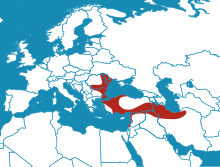Dolbina elegans
| Dolbina elegans | ||||||||||||
|---|---|---|---|---|---|---|---|---|---|---|---|---|
| Systematics | ||||||||||||
|
||||||||||||
| Scientific name | ||||||||||||
| Dolbina elegans | ||||||||||||
| A. Bang-Haas , 1912 |
Dolbina elegans is a butterfly ( moth ) from the family of moth (Sphingidae).
features
The moths reach a wingspan of 40 to 53 millimeters. They are colored in different shades of brown to black-gray and are therefore relatively inconspicuous. Eggs, caterpillars and pupae are unknown, it is assumed that the caterpillars are yellowish in color after hatching.
Occurrence
The species is distributed from the Ukraine, Moldova, over the east of Romania and the east and south of Bulgaria, the north of Greece, the west and south of Turkey to the north of Syria, west Jordan, Israel, the northern Iraq and northern Iran. However, based on the current state of research, it cannot be ruled out that it is also widespread in other parts of Asia.
The animals mainly colonize light forests and bushland along alluvial alluvial land in farmed valleys and wooded gorges adjacent to them. In some regions the species is restricted to the latter habitats due to over-management and habitat destruction . In Israel and Jordan , the species is found in wooded, damp ravines bordering rivers. These habitats are more humid than the surrounding areas, which means that they are overgrown with numerous small ash trees, which are covered by a closed canopy.
Way of life
The way of life of the caterpillars is also unknown. It is believed that the nature as well as the remaining Asian common species of the genus dolbina of ash ( Fraxinus fed). The adults fly in two, sometimes three generations from April / May to the beginning of September. In Europe, they mainly fly in July, although they are also regularly found in the south of Bulgaria in April and July. The animals are not very active and only fly close to the ground in a short time after dusk. It is unknown which parasitoids attack the species.
supporting documents
Individual evidence
- ↑ a b c d Sphingidae of the Western Palaearctic. AR Pittaway, accessed April 7, 2010 .
literature
- Ian J. Kitching, Jean-Marie Cadiou: Hawkmoths of the World. An Annotated and Illustrated Revisionary Checklist (Lepidoptera: Sphingidae). Cornell University Press, New York 2000, ISBN 0-801-43734-2
- AR Pittaway: The Hawkmoths of the western Palaearctic. Harley Books 1993, ISBN 0-946-58921-6
Web links
- Fauna Europaea: Taxonomy (English)
